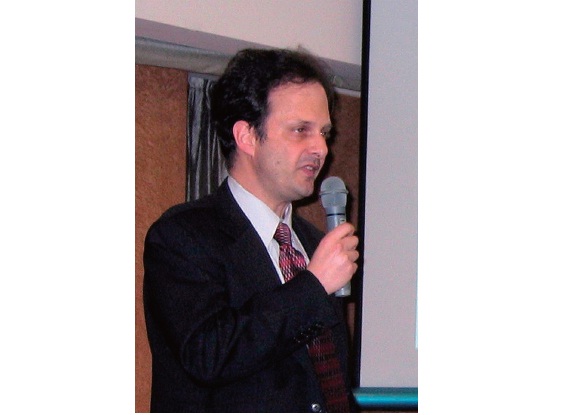Mr. Carl Kay, Tokyo-based entrepreneur and author
by Bill Steele
WHEN OUTSIDERS talk about Japan, the phrase okyakusama wa kamisama — “the customer is God” — frequently pops up. Whether it’s the white glove service from taxi drivers or the exceedingly polite department store clerks, Japan has a reputation for providing customers with uniformly excellent and elegant service, arguably the best in the world.
But as author Carl Kay explained to an audience of entrepreneurs at EA-Tokyo’s April 2005 seminar, Japan’s service market isn’t the consumer paradise many believe it to be. In fact, he says, it’s a “trillion dollar hole” of opportunity waiting to be filled by innovative entrepreneurs.
Kay’s recent book, “Say Yes to Japan — How Outsiders Are Reviving a Trillion Dollar Services Market”, co-authored with U.S.-based entrepreneur Tim Clark, details some of these shortcomings:
• Irresponsible lending practices, discrimination and a host of unwritten rules that shortchange customers in the banking industry
• Bad service at hospitals, where patients are often subjected to poor hygiene, treated by incompetent doctors and underprovided by available technology
• Sleazy rental practices, conflicts of interest and lack of transparency at real estate agencies
• Loan sharking, usurious interest rates and other shady dealings in the financial services industry
• Burdensome regulations, low competition, protection for inefficient players, and other arcane business practices that provide little value to consumers.
In essence, Kay says, while many Japanese consumers enjoy an exemplary level of service when visiting gas stations or getting their gifts wrapped, their critical, “deeper level” service needs are not being met.
Kay says banks are an instructive example of how Japan’s service sector hurts consumers and, ultimately, hampers the economy. It is quite common, for example, that Japanese banks make superficial judgments on the credit worthiness of their customers based on who they work for; the more prestigious the company, the better the deal. Loan interest rates are just a few percent for qualified customers, but those who fail to meet lending criteria must pay up to 30% at consumer finance companies which are allowed legally to lend at loan shark-like rates of 30% per year. The entire middle of the market, where rates of 6–15% would be expected for medium risk customers, barely exists in Japan. On the other side of the equation, he says, banks consistently offer investment products paying absurdly low rates. Other irresponsible examples include an unwritten policy at some banks that bars single women and foreigners from home mortgage loans and refusal of loans to self-employed individuals even if they have sufficient assets and income.
The upside of all these problems, Kay says, is that an enormous opportunity exists for innovation in Japan’s service sector for those willing to take bold risks. In many cases, domestic competitors simply lack the methods and techniques common overseas. In others, outsiders can create powerful advantages over competitors simply by injecting common sense and rationality into existing processes.
One example of an entrepreneur who has already made inroads is American Seth Sulkin who developed a shopping mall called “Vivit Square” based on an American mall model. Vivit’s shopper-friendly features have made it a huge hit among consumers. Sulkin did what Kay and Clark call in the book “cultural arbitrage” — exploit business practice gaps between cultures. More simply put, foreign entrepreneurs take advantage of their foreigner status to bring innovation to a previously stultified market.
“Seth isn’t chasing fashion, or competing on price. He’s just taken something common in his own country and adopted it in Japan,” Kay says.
Kay points out that now is the best time for entrepreneurs to jump into the Japanese services industry. Due to recent reforms, he says, it is easier than ever for outsiders to start businesses here. The bottom line is, Japan’s domestic economy needs revitalization that will no longer come from population increases. As the population ages, economic expansion will likely come through delivering better ideas, strategies and approaches in critical, not trivial, services. The key for entrepreneurs, Kay says, will be to:
• Apply standards and proven service methodologies
• Take advantage of the speed and flexibility enabled by IT
• Take bold risks, be flexible, and use good risk management practices
• Deliver greater professionalism to Japan
• Maintain customer focus
Employing such strategies, Kay says, will lead to success for entrepreneurs in Japan’s multi-trillion dollar services economy.
See more about Clark and Kay’s book, “Saying Yes to Japan— How Outsiders Are Reviving a Trillion Dollar Services Market” at the book’s web site www.sayingyestojapan.com.









